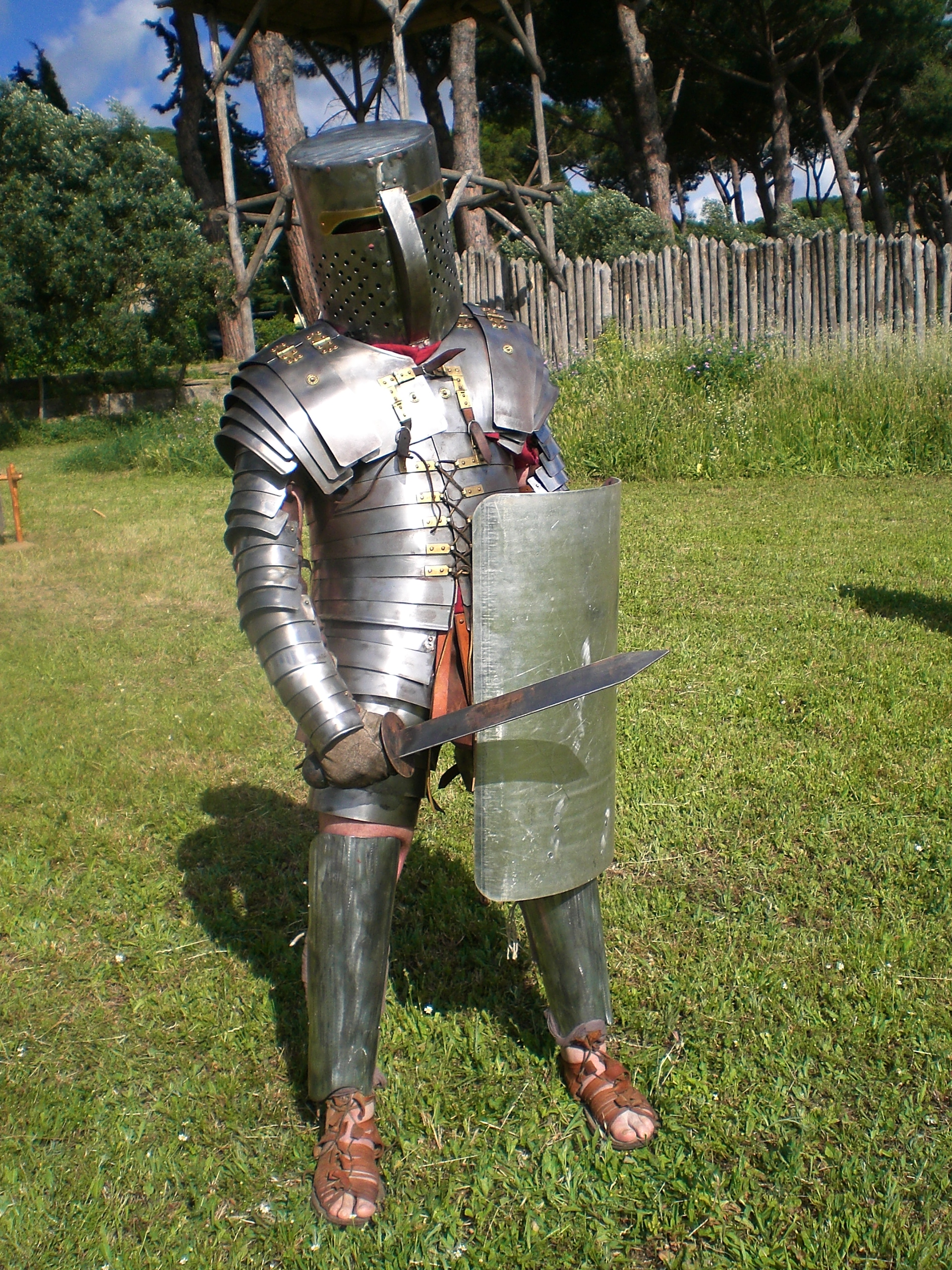Crupellarius LegioXXX 3 on:
[Wikipedia]
[Google]
[Amazon]
 A crupellarius ( la, Crupellarius, pl. Crupellarii) was a type of heavy armored
A crupellarius ( la, Crupellarius, pl. Crupellarii) was a type of heavy armored
Durolitum.co.uk/gladtypes
 A crupellarius ( la, Crupellarius, pl. Crupellarii) was a type of heavy armored
A crupellarius ( la, Crupellarius, pl. Crupellarii) was a type of heavy armored gladiator
A gladiator ( la, gladiator, "swordsman", from , "sword") was an armed combatant who entertained audiences in the Roman Republic and Roman Empire in violent confrontations with other gladiators, wild animals, and condemned criminals. Some gla ...
during the Roman Imperial age, whose origin was Gaul.
Equipment and style
The standard crupellarius was clad almost entirely from head to foot in '' lorica segmentata'' orlaminar armour
Laminar armour (from la, lamina – layer) is an armour made from horizontal overlapping rows or bands of, usually small, solid armour plates called lames, as opposed to lamellar armour, which is made from individual armour scales laced together ...
, which consisted of strips of malleable iron that was layered. Other variations of this armor were similar to manica. The crupellarius carried a scutum
The ''scutum'' (; plural ''scuta'') was a type of shield used among Italic peoples in antiquity, most notably by the army of ancient Rome starting about the fourth century BC.
The Romans adopted it when they switched from the military formati ...
and gladius; the shield was most likely either oval, rectangular or circular. These shields were usually made of wood in a laminate type structure and bound in leather strips, durable enough to deflect sword strikes and projectiles but also light enough to be held in tow with just one arm.
Crupellarii wore a helmet resembling a perforated bucket, with only very small openings for the eyes and mouth, similar to a medieval Great helm
The great helm or heaume, also called pot helm, bucket helm and barrel helm, is a helmet of the High Middle Ages which arose in the late twelfth century in the context of the Crusades and remained in use until the fourteenth century. The barreled ...
, which resulted in poor visual acuity in battle. Iron was incorporated more due to how simple it was to produce however bronze fittings were more prone to being corroded as well as leather bindings which had a tendency to tether and rot over time. This style of armor was most popular during the Principate and seems to have been used sporadically after the 3rd century CE.
Thus, the crupellarius' fighting style was suited for men with a large muscular build, able to withstand the weight of the heavy plate armor he wore, as he was one of the most heavily encumbered gladiators with the amount of layered plated iron (especially given the absence of gauntlets and sabatons). The crupellarius are more defense orientated, depending on his stamina and endurance to survive the battle, tiring out attacking foes before counterattacking them when they are worn out. This can explain as to why their armor is heavily layered hence having limited movement speed as well as clad in a helmet that would have obstructed most of their vision due to the very small openings in the helmet.
In literature
Crupellarii were first mentioned by the 1st century AD historian Tacitus. Under the reign of the2nd
A second is the base unit of time in the International System of Units (SI).
Second, Seconds or 2nd may also refer to:
Mathematics
* 2 (number), as an ordinal (also written as ''2nd'' or ''2d'')
* Second of arc, an angular measurement unit ...
Roman Emperor, Tiberius, a faction of Treveri led by Julius Florus
Three main sets of works are attributed to Florus (a Roman cognomen): ''Virgilius orator an poeta'', an Epitome of Roman History and a collection of 14 short poems (66 lines in all). As to whether these were composed by the same person, or set of ...
, and the Aedui, led by Julius Sacrovir, led a rebellion of Gaulish debtors against the Romans in 21 CE. Cornelius Tacitus (117 CE), '' Annales III:40-46''. The crupellarii, heavily armoured Gallic gladiators, fought against Roman legionaries.''Britannia''Durolitum.co.uk/gladtypes
In addition were some slaves who were being trained for gladiators, clad after the national fashion in a complete covering of steel. They were called crupellarii, and though they were ill-adapted for inflicting wounds, they were impenetrable to them...
...the cavalry threw itself on the flanks, and the infantry charged the van. On the wings there was but a brief resistance. The men in mail were somewhat of an obstacle, as the iron plates did not yield to javelins or swords; but our men, snatching up hatchets and pickaxes, hacked at their bodies and their armour as if they were battering a wall. Some beat down the unwieldy mass with pikes and forked poles, and they were left lying on the ground, without an effort to rise, like dead men.
Class rank
Although not much is known about their extensive arena presence, crupellarius gladiators most likely belonged to a class called laqueariusbr>See also
* List of Roman gladiator typesReferences
{{reflist Gladiator types